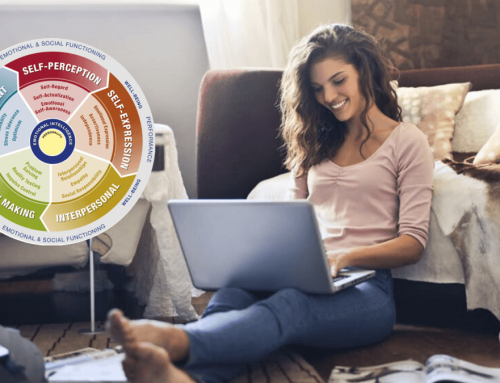Start to feel more relaxed and confident and put energy into what matters.
Why do a staggering 40 percent of adults suffer from an anxiety disorder on a regular basis, making it the most common form of mental illness in the U.S?
The primary cause of anxiety’s steady climb since the Great Depression is uncertainty. Generally, people like being able to predict what’s next, and not knowing creates distress. In fact, the Intolerance of Uncertainty Scale (IU) developed by Quebec scientists confirms that high IU is linked to generalized anxiety disorder (GAD) and worry.
We worry when we think about possible future threats while also feeling the emotional and physical symptoms of anxiety. Depending on how well one tolerates the groundlessness of life – not knowing what to do, what is coming or what others are thinking – a range of triggers induce anxiety. In this way, both GAD and subclinical anxiety exist on a continuum and is predicated by our reactions to environmental factors. Not all uncertainty is bad, though. We tend to become excited and even work harder when the size of the reward is unknown – but to a certain point. It is when the stakes get too high that excitement can shift to fear or even terror.
The 3-P Poison Pill of Anxiety
So what are the true primary contributors to anxiety? We like to think about it in terms of three P’s.
PERSPECTIVE
Where are you? Where do you want to be? The greater the gap between those two, the higher your likely level of anxiety. Many people want an immediate pot of gold in the bank. Of course, we all need to invest material effort to achieve success, but science says working more than 40 hours a week often backfires and even harms our health. And those seeking immediate and exorbitant riches work relentlessly to achieve their goal and hardly ever arrive because their present expectation gap is so large. If your anxiety levels are high, the first question to ask yourself is whether you have established small, manageable milestones toward your goal and if even those “small” bites are realistic. You’ve heard it before. Slow and steady wins the race.
PRESSURE
Why do so many people place themselves in situation that induce anxiety through undue pressure? Consider the manufactured strain some place on themselves to finish binge-watching a program, ironically converting the calming benefits of recreation into pressure. Speaking of irony, anxiety creates adrenaline, which is naturally addictive. So much pressure arises from the subconscious need for more anxiety in life.
PERMISSION
Many of us don’t give ourselves permission to step away from anxiety when it is at its height or even think of doing so. If life’s uncertainties have become a hazard to your wellbeing, it is time to take a step back and shift your approach. Give yourself permission to step away from those things in life that seem to be triggering the most anxiety. It could be as simple as going for a 15-minute walk, looking at images and sounds of nature, or it could require taking a deep look at how you spend your time and the people you have in your life. Self-awareness is the first step here. From there, popping the permission pill will give you space to assess the best next step(s) to improve your mental health.
The Solutions
THE MINDFULNESS SOLUTION
It takes as little as 10 seconds to disrupt the momentum of stress, and frequent disruption can be your greatest weapon in beating anxiety. Make a conscious effort to monitor your stress. When you are feeling particularly stressed, try this anti-anxiety breathing exercise for two to three minutes at a time.
What’s more, remember the expectation gap above? It holds true in the current moment as much as it does over a number of years. When you are feeling anxious, think about your current situation and what you wish it was. Then try adjusting your expectations to align with the way things currently are. You’ll be amazed at how calming that is. To reach an even more tranquil state, take deep breaths to lower your cortisol levels and therefore, your stress.
It is also important to understand your triggers, and there is an effective mechanism to accomplish that. Replay in slow motion the last event that triggered an unwanted emotional response. Sit with the event and take slow, deep breaths. Then, write down the answers to the following questions (adapted from Dr. Rick Hanson, Ph.D., author of Buddha’s Brain.)
- What moments of the event are resonating with you the most?
- Without judgement, become aware of the emotions and feelings arising. Simply ask yourself, “What am I feeling?” On a scale of 1-10, record how intensely you’re experiencing each sensation.
- Notice any other toxic thinking patterns associated with the experience. Detach yourself from them as if you’re the observer, and record any negative self-talk.
- Now, change the story you’ve created and write down statements that affirm your negative reaction. You can say, “It’s no wonder I felt so offended by so-and-so because I’m telling myself, ‘I’m not smart enough…others are better than I am.’” We have control over our own thoughts. So, only choose those that build up your confidence. There is great power in that!
Writing your answers can give you a clearer sense of how you handle stressful situations, invoke greater accountability and ownership over your behaviors and provide a baseline to revisit as you assess progress made.
For those seeking additional guidance, seeing a psychologist/counselor or a psychiatrist if medicine becomes necessary is an excellent way to address anxiety. But if you have the patience and willpower, mindfulness and other techniques above are free and effective tools. With a little knowledge of who you are, you can always prescribe some of your own medicine.
This article originally appeared on Psychology Today Jan 07, 2018
Sign up here to receive articles and updates from Laura Berger.






Leave A Comment